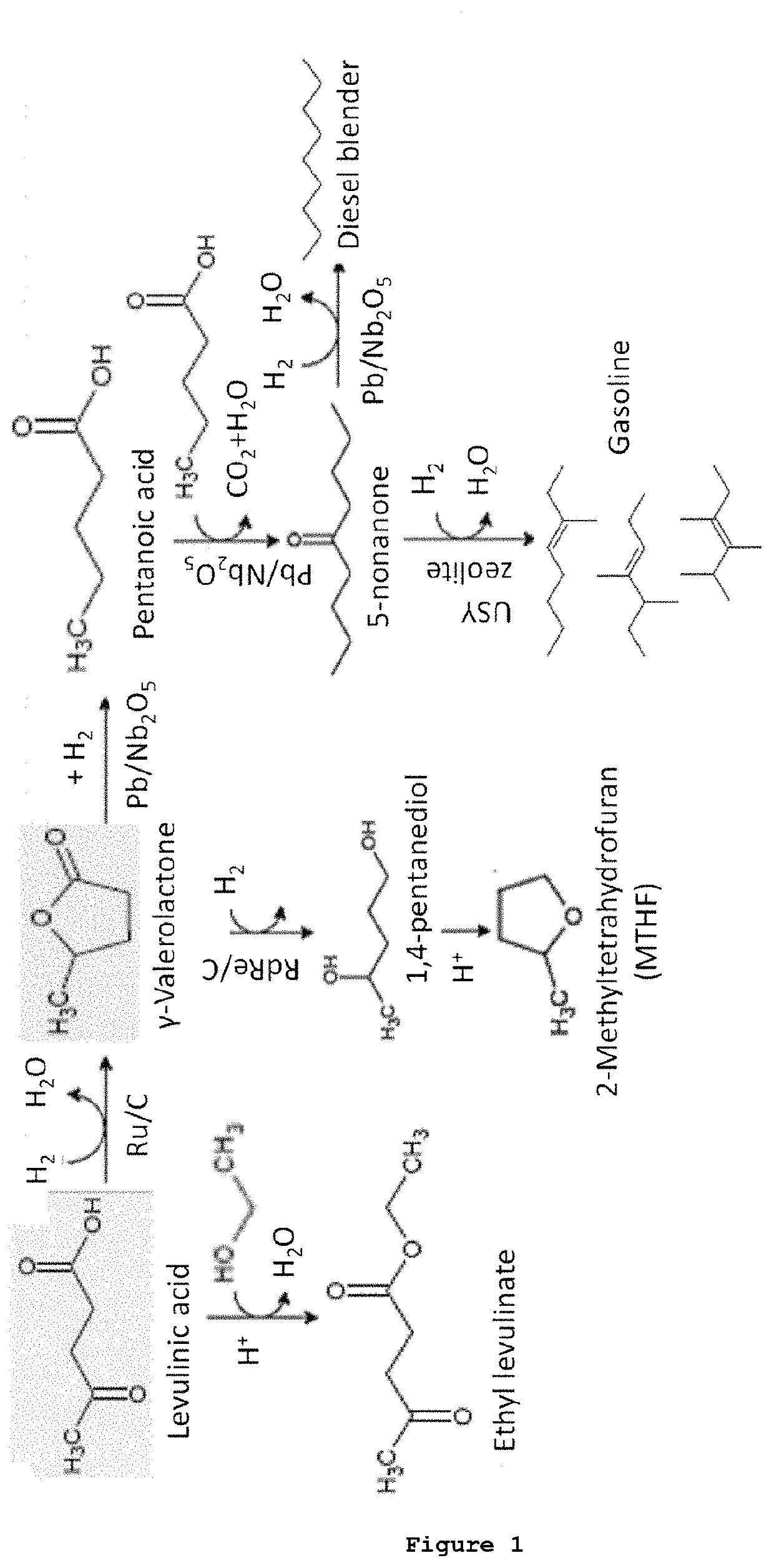Levulinic acid purification
a technology of levulinic acid and purification, applied in solvent extraction, vacuum distillation separation, separation processes, etc., can solve the problems of insufficient purity and and achieve the effect of improving the yield of levulinic acid and reducing the presence of impurities
- Summary
- Abstract
- Description
- Claims
- Application Information
AI Technical Summary
Benefits of technology
Problems solved by technology
Method used
Image
Examples
example 1
n of an Aqueous Phase Enriched in Levulinic Acid
[0297]A biomass slurry formed by bleached lignocellulosic pulp in water was obtained by crushing, grinding, bleaching and dispersing lignocellulose biomass in a solution to create a slurry. The weight percentage of cellulose present in said biomass slurry was between 2.5 wt % and 9 wt % with respect to the total weight of the slurry. Said biomass slurry, with a ratio of liquid-solid of 3.5-10, was heated up to between 165-180° C. at a pressure of 7-10 barg in a hydrolysis reactor during between 0.5 and 4 h under stirring. Upon reaching said temperature and pressure values, sulfuric acid was injected until a sulfuric acid concentration of 2-4 wt % with respect to the total weight of the reaction mixture was reached. Then, the mixture was discharged and cooled down to room temperature. The solids were filtered off resulting in a liquid biomass hydrolysate (or liquor) comprising approximately 1.5-2 wt % levulinic acid (LEVA), 0.75-1 wt % ...
example 1a
on Procedure a of Levulinic Acid by a Double Extraction Followed by a Distillation
[0299]A first liquid-liquid extraction of LEVA from the aqueous solution (liquid biomass hydrolysate or liquor) was performed in an extraction column resulting in an organic solution comprising levulinic acid, and an aqueous solution. Methyl isobutyl ketone (MIBK) was used as organic solvent in a ratio of between 0.25:1 and 1:5 MIBK:liquor. The solvent and the liquor were fed to the extraction column at room temperature. After 12-2 extraction stages with contact times of 1-20 min an organic phase enriched in LEVA was collected. The efficiency of this extraction step was between 90%-98% for the levulinic acid and 90%-98% in the case of formic acid. Therefore, there was a 0.3-7.5 wt % of levulinic acid, a 0.15-4 wt % of formic acid in the obtained organic phase and between a 0.15 and 0.5 wt % of residues. Thus the ratio levulinic acid:residue was 1:0.6 in said organic phase.
[0300]The organic phase enrich...
example 1b
on Procedure B of Levulinic Acid by a Double Extraction Followed by a Nanofiltration and a Distillation
[0304]The aqueous solution (liquid biomass hydrolysate or liquor) obtained in Example 1 followed the same procedure explained in example 1A for the purification of levulinic acid but including an additional step of a nanofiltration (membrane separation) after the aqueous liquid-liquid extraction step.
[0305]The aqueous solution obtained after the aqueous extraction step is separated (nanofiltrated) in a membrane unit. Transmembrane pressure is set on 20-40 bars and temperature kept at room T° C. The membrane is a DL Lenntech 150-300 Da. The permeate produced had a clear yellow color. The flux on average is between 40-60 l / m2·h. The retentate obtained is diluted and optionally recirculated through the membrane. The calculated retention percentage (R), R=(100(1-(Cpermeate / Cretentate))) for levulinic acid is around 15-25%. And the permeate percentage (P), P=(100(Cpermeate / Cretentate)) ...
PUM
| Property | Measurement | Unit |
|---|---|---|
| Temperature | aaaaa | aaaaa |
| Time | aaaaa | aaaaa |
| Concentration | aaaaa | aaaaa |
Abstract
Description
Claims
Application Information
 Login to View More
Login to View More - R&D
- Intellectual Property
- Life Sciences
- Materials
- Tech Scout
- Unparalleled Data Quality
- Higher Quality Content
- 60% Fewer Hallucinations
Browse by: Latest US Patents, China's latest patents, Technical Efficacy Thesaurus, Application Domain, Technology Topic, Popular Technical Reports.
© 2025 PatSnap. All rights reserved.Legal|Privacy policy|Modern Slavery Act Transparency Statement|Sitemap|About US| Contact US: help@patsnap.com


